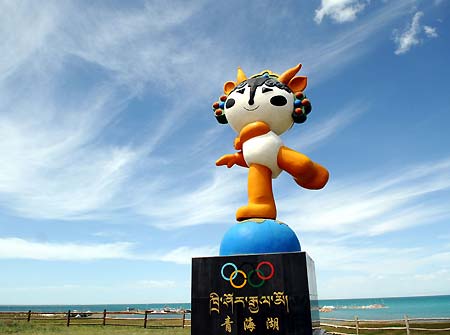 A statue of Yingying the Tibetan antelope, one of the five mascots of the Beijing Olympic Games, is seen in Qinghai, June 22, 2008. [Xinhua]
A statue of Yingying the Tibetan antelope, one of the five mascots of the Beijing Olympic Games, is seen in Qinghai, June 22, 2008. [Xinhua] |
GOLMUD, Qinghai: At first, he is as shy as the Tibetan antelopes (or chiru) he protects. But the sight of Yingying, one of the five mascots of the Beijing Olympic Games, brings about a distinct change in him because it represents the Tibetan antelope.
"The media calls me the 'Guard of Tibetan Antelopes', but personally I prefer what my friends and associates call me: Tibetan Antelopes' Daddy," says Cega, who Sunday became the first Olympic torchbearer in Qinghai province. The 56-year-old military officer has been fighting poachers to protect the chirus in Hol Xil Nature Reserve for the past decade.
Before replying to the next question, Cega picks up the doll (Yingying). A smile breaks out on his face as he holds it tightly, and recounts his experience with the endangered species.
 Cega: "Daddy of Chiru." [Xinhua]
Cega: "Daddy of Chiru." [Xinhua] |
Cega is an ethnic Tibetan, and was born into a herdsman family in Yushu, a county in Qinghai. He has been the director of the Hol Xil Nature Reserve Administration since 1998.
He did not "know much" about the chiru as a child, even though his hometown was just 50 km from the Hol Xil Nature Reserve, the world's largest natural reserve without human settlement.
His first encounter with the antelope was in 1979 when he was stationed in his hometown as a solider.
But what turned him into a conservator was the news of Sonam Dargyi's death in 1993. Dargyi was the leader of a volunteer patrol team of local Tibetan and Han people trying to protect the Tibetan antelope, was killed by poachers. His real-life story was later made into a film, Ke Ke Xi Li, by Chinese director Lu Chuan, and nominated for the Best Foreign Language Film Award at the 2005 Oscars.
Dargyi's death made Cega realize the importance of wildlife and the environment and the dangers they faced from poachers and polluters.
By the time Cega was appointed director of the reserve, the antelopes' number had dwindled to below 20,000, making it one of the world's top 10 most endangered species.
Cega had Dargyi's footsteps to follow. He led a team of passionate people, ready to risk their lives against the armed poachers.
Team member and fellow Tibetan Wang Zhoutai, standing close by, breaks in: "For five to six years, our director didn't go home We respect him for that and everything he has done to save the chiru."
Thanks to the team's efforts, the number of antelopes have kept rising. It had almost doubled to 40,000 by 2005, when the Beijing Olympic Games organizers were looking for an animal as one of their mascots.
Cega thought no other animal would be better as an Olympic mascot. It's the symbol of "tenacity, indomitable spirit, robust physique, endurance and stamina", things you would look for in a good athlete.
After years of leading his team in the fight against poachers, Cega thought it was time to invite the world to join their efforts to protect the antelope. So he submitted a proposal recommending the antelope as one of the Olympic mascots, and spent about two months lecturing about its importance and the environment to college students across China.
Thanks to his efforts, the chiru jumped from the bottom of the online voting on the Games mascots in the first two weeks to the top in the end.
He derives the greatest comfort from the fact that "no gunshots have been heard in the reserve ever since the antelope has become Yingying Their number in the reserve has jumped to about 60,000".